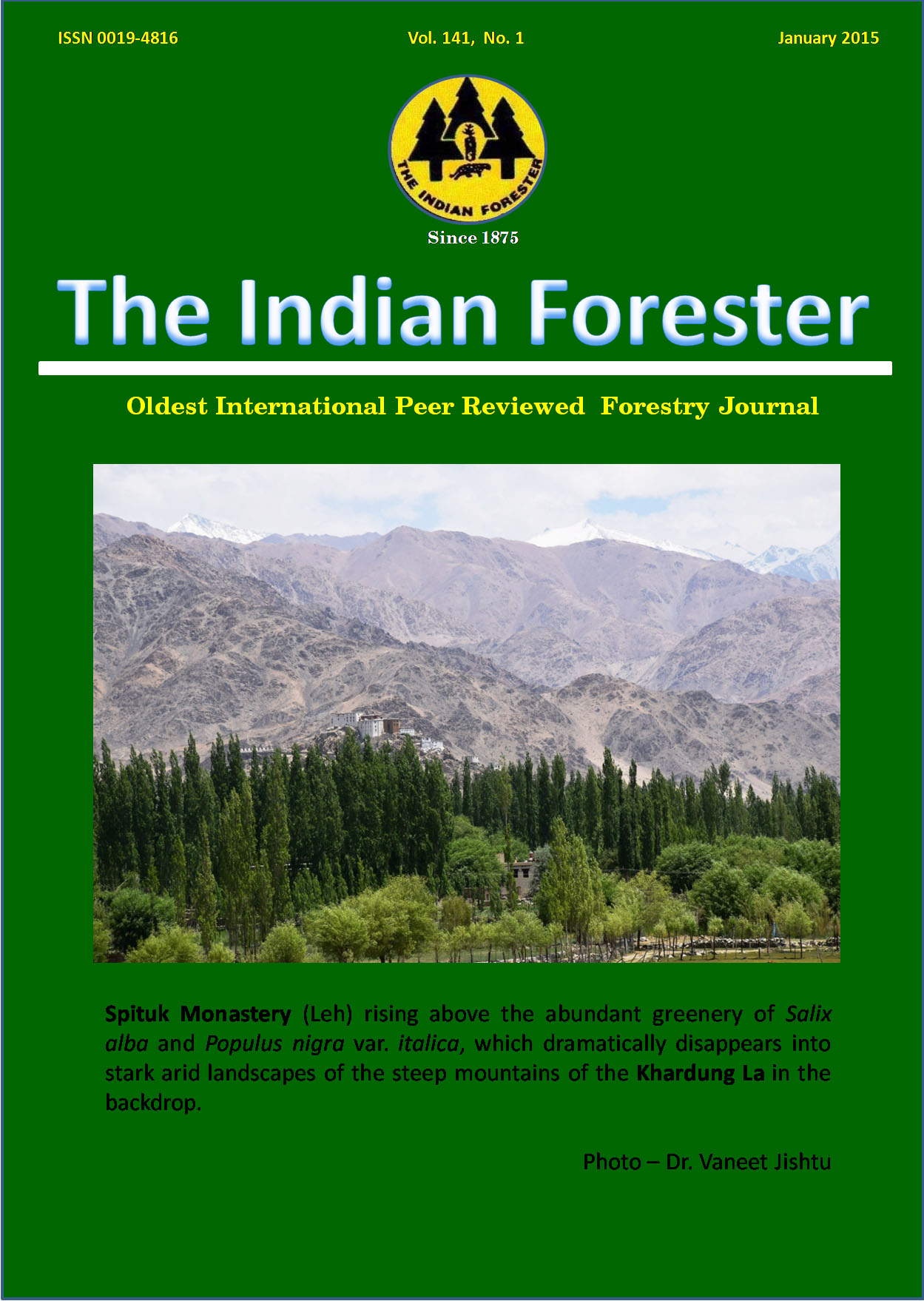Effect of Growing Media and Inorganic Phosphorus on Growth and Development of Maggar Bans (Dendrocalamus hamiltonii Munro) Planting Stock
DOI:
https://doi.org/10.36808/if/2015/v141i1/56826Keywords:
Growing Medium, Bamboo, Quality Planting Stock, Underground Biomass, Growth And Development, Propagule.Abstract
Studies were conducted to investigate the effect of five growing mediums and four levels of inorganic phosphorus on the growth and development of Dendrocalamus hamiltonii planting stock under mid-hill conditions of north-western Himalayas. The growing medium and phosphorus levels significantly influenced various growth and development traits individually as well as in combinations. The growing medium viz., sand + soil + FYM (1:1:1) proved to be significantly superior for enhancing height and diameter growth of the tiller's, number of tiller per sapling, number of nodes per tiller, number of roots, length of roots, number of rhizomes, dry weight of stem, roots, rhizomes and underground biomass. Among the various levels of phosphorus, 5 g SSP/propagule significantly proved to be the best dose. In combination effect, the maximum dry weight of rhizome (2.82 g plant-1 ) and underground biomass (9.69 g plant-1 ) was recorded in the propagules grown in sand: soil: FYM (1:1:1 ) and supplied with P @ 5 g SSP/propagule.References
Barea J.M., Azocom A.C. and Azcom R. (1987). Vesicular arbuscular mycorrhiza improves both symbiotic N fixation and N uptake from soil as assessed with 15 N techniques under field conditions. New Phytol., 106: 717-725.
Founoune H., Duponnois R., Ba A.M. and Boumai F.E. (2002). Influence of dual arbuscular endomycorrhizal/ectomycorrhizal symbiosis on growth of Acacia holosericea (A. Cunn. Ex G.Don.) in glasshouse conditions. Ann. For. Sci., 59: 93-98.
Hartmann H.T., Kester D.E., Davies F.E. and Geneve R. (2007). Plant Propgation: Principles and practices of plant propagation. 7th edition. New Delhi: Prentice Hall of India Private Limited, 880p.
Kim K.Y., Jordon D. and McDonald G.A. (1998). Effect of phosphate solubilizing bacteria and vesicular-arbuscular mycorrhizae on tomato growth and soil microbial activity. Biol. Fertil. Soils., 26: 79-87.
Kumar A., Mohinder P. and Shiv K. (1992). Mass production of field planting stock of Dendrocalamus hamiltonii vegetatively through macroproliferation. Ind. For., 118(9): 638-646.
Kumar A., Gupta B.B. and Negi D.S. (1991). Vegetative propagation of Dendrocalamus strictus through macro-proliferation-II. Ind. For., 117: 620-628.
Macek P. and Rejmankova E. (2007). Response of emergent macrophyttes to experimental nutrient and salinity addition. Functional Ecology. 21: 478-488.
Merwin H.D. and Peach M. (1951). Exchangeability of soil potassium in sand, silt and clay fraction as influenced by the nature of complementary exchangeable cations. Soil Science Society American Proceeding, 15: 125-128.
Muthukumar T. and Udaiyan K. (2006). Growth of nursery grown bamboo inoculated with arbuscular mycorrhizal fungi and plant growth promoting rhizobacteria in two tropical soil types with and without fertilizer application. New Forests., 31: 469-485.
Negi M. Sachdev M.S. and Tilak K.V. B. R. (1990). Influence of soluble phosphorus fertilizer on the interaction between a vesicular arbuscular mycorrhizal fungus and Azospirillum brasilense in barley (Hordeum vulgare L.). Biol. Fertil. Soil., 10: 57-60.
Olsen S.R. Cole C.V. Watanabe F.S. and Dean L.A. 1954 Estimation of available phosphorus in soils by extraction with sodium bicarbonate, United States Department of Agriculture circular, 939: 19-33.
Piper C.S. (1966). Soil and plant analysis, Hans Publishers, Bombay, India.
Prasad A., Khatri P.K., Bhoumik K.A.K., Totey N.G. and Prasad A. (1990). Effect of Phosphorus on the growth of Bamboo (Dendrocalamus strictus), Journal of the Indian Society of soil science, 38(4): 765-766.
Raina A.K., Prasad K.G., Pharasi S.C., Kapoor K.S. and Singh S.B. (1988). Effect of nutrients on the growth behaviour of Bambusa tulda in the nursery. Ind. For., 114(9): 584-591.
Russell E.W. (1975). Soil condition and plant growth, The English Language Book Society and Longman, London.
Subbiah B.V. and Asija G. l. (1956). A rapid procedure for the estimation of available nitrogen on soil. Current Science, 25: 259-260.
Suityono (1995). The growth of Gagantochloa apus at two year old. Bulletin-Penelitian-Hutan. No.598: 68-79.
Sun T.R. and Ye C.C. (1988). Study on the soil of the fish scale bamboo forest and the biomass of its underground rhizomes. Journal of Bamboo Research, 7(3): 54-65.
Totey N.G., Kapoor K.S., Kulkarni R., Khatri P.K., Chauhan D.C., Bhawani A.K., Dhahid V.K. and Prasad A. (1988). Effect of nitrogen and phosphorous fertilizers on growth and yield of bamboo seedling. (D. strictus). Ind. For., 114(9): 592-598.
Walkley A. and Black C.A. (1934). An examination of degtjareff method for determining soil organic matter and a proposed modification of the chromic acid titration method. Soil Science, 37: 29-39.
Downloads
Downloads
How to Cite
Issue
Section
License
Unless otherwise stated, copyright or similar rights in all materials presented on the site, including graphical images, are owned by Indian Forester.





